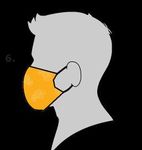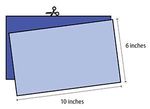Guidelines for Wearing a Face Mask - Guidelines - Covid.gov.pk
←
→
Page content transcription
If your browser does not render page correctly, please read the page content below
Date: 06 May 2020
Document Code: 17-02
Version: 02
Guidelines
Guidelines for Wearing a Face Mask
Objective
To provide guidelines to the public for wearing a face mask during the current epidemic of COVID-19.
Rationale
A regular disposable face mask (also called a surgical face mask or a medical face mask) is considered
as one of the ‘Personal Protective Equipment (PPE)’ of a health care worker. It is also used in the
healthcare settings to cover the face of a patient, from whom spread of a communicable infection is a
possibility.
As regards COVID-19, there is now evidence to believe that a person infected with COVID-19 virus
may appear well for a variable period before falling ill or may never exhibit any symptoms yet is
shedding virus during sneezing, coughing and while speaking. As it is not possible for someone to
know with certitude if he or she is carrying COVID-19 virus and releasing these in the atmosphere, it
may be prudent, under the circumstances of the current epidemic, for the people to wear face masks
with an intention to protect themselves and their fellow beings from droplets of saliva/sputum
particularly when entering closed or congested areas. Many countries have adopted this as a national
guideline.
Instructions
It is pertinent to remember that use of ordinary face mask is not a substitute for adoption of
social distancing and at no time distancing be abandoned wherever required in addition to
regular handwashing with soap and water.
In a health care setting, all the health care workers shall follow the guidelines for wearing PPE.
Patients shall follow the advice of their doctors.
All covid-19 positive and suspected individuals must wear disposable facemasks to ensure that
others around them are protected from droplets generated by the positive person while
breathing, talking, coughing or sneezing.
Facemask should be worn by public when in following situations
o Public transport
o Crowded places (mosques, mass gatherings, shopping malls etc)
o Meetings in closed rooms/conference halls
o Shops, offices, industrial premises, any workplace in closed environment
1 Healthy individuals may choose to wear a disposable face mask or any other available face
mask (cloth mask as indicated in Annex)) on leaving their home with the intention of protecting
themselves and others with whom they may come in close contact.
Once the mask is worn, it is part of the face and it must not be touched with hands throughout
its use.
The mask should be replaced with a new one when it gets soiled or becomes moist.
The soiled disposable mask shall be disposed off properly and the reusable one shall be placed
in a sealable polythene bag and placed in a dedicated pocket of the dress or in a dedicated
pocket of a washable handbag.
Cloth masked should be washed thoroughly with soap & water or bleach after use and can be re
used when clean.
Hands must be washed with soap and water or sanitized with an alcohol-based hand rub
according to the guidelines of hand hygiene, after handling a used face mask.
The pocket of the dress or the bag, in which a soiled mask was saved, shall not be used or
handled for any other purpose before washing.
N95 mask is only needed in high risk healthcare facilities by the health workers and is
beneficial only when worn with special precautions and appropriate procedures.
Note: The above recommendations are being regularly reviewed by the Ministry of National Health Services, Regulations &
Coordination and will be updated based on the international & national recommendations and best practices.
The Ministry acknowledges the contribution of Irfan Mirza and HSA/ HPSIU/ NIH team to compile these guidelines.
References:
1. Use of Cloth Face Coverings to Help Slow the Spread of COVID-19, CDC,
https://www.cdc.gov/coronavirus/2019-ncov/prevent-getting-sick/diy-cloth-face-coverings.html
2. Rational use of personal protective equipment (PPE) for coronavirus disease (COVID-19) by WHO
3. Interim recommendations for the use of personal protective equipment (PPE) during hospital care of people
with Coronavirus disease (COVID-19)
For more information, please contact:
HSA/ HPSIU/ NIH, PM National Health Complex, Islamabad
http://covid.gov.pk/
http://nhsrc.gov.pk/ https://www.facebook.com/NHSRCOfficial
http://www.hsa.edu.pk/ https://twitter.com/nhsrcofficial
https://www.nih.org.pk/ https://www.youtube.com/channel/UCdYuzeSP4Ug1f__ZZKLDiYg
2ANNEXURE: MAKING OF CLOTH FACE MASKS (CDC)
SEWN CLOTH FACE COVERING
Materials
Two 10”x6” rectangles of cotton fabric
Two 6” pieces of elastic (or rubber bands, string, cloth strips, or hair
ties)
Needle and thread (or bobby pin)
Scissors
Sewing machine
Tutorial
1. Cut out two 10-by-6-inch rectangles of cotton 2. Fold over the long sides ¼ inch and hem. Then
fabric. Use tightly woven cotton, such as quilting fold the double layer of fabric over ½ inch along the
fabric or cotton sheets. T-shirt fabric will work in a short sides and stitch down.
pinch. Stack the two rectangles; you will sew the
mask as if it was a single piece of fabric.
3. Run a 6-inch length of 1/8-inch wide elastic 4. Gently pull on the elastic so that the knots are
through the wider hem on each side of the mask. tucked inside the hem. Gather the sides of the mask
These will be the ear loops. Use a large needle or a on the elastic and adjust so the mask fits your face.
bobby pin to thread it through. Tie the ends tight. Then securely stitch the elastic in place to keep it
from slipping.
3BANDANA FACE COVERING (NO SEW METHOD)
Materials
Bandana (or square cotton cloth approximately 20”x20”)
Rubber bands (or hair ties)
Scissors (if you are cutting your own cloth)
Tutorial
4You can also read























































